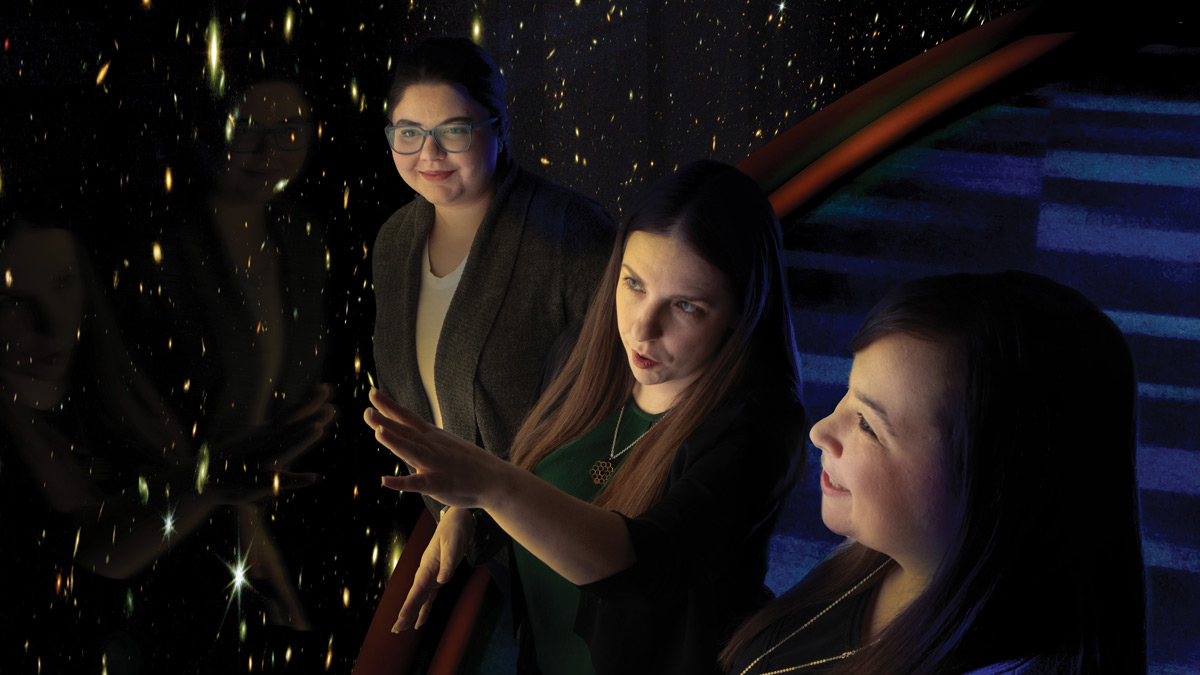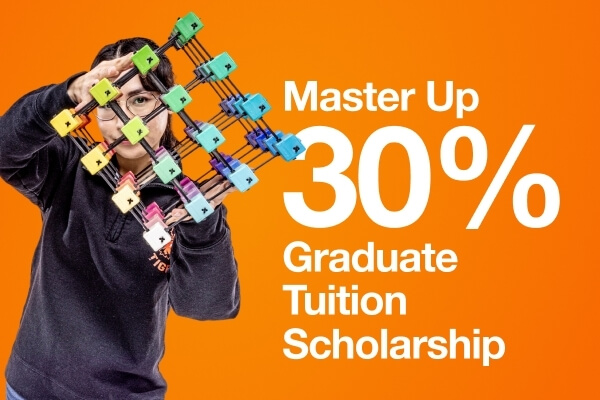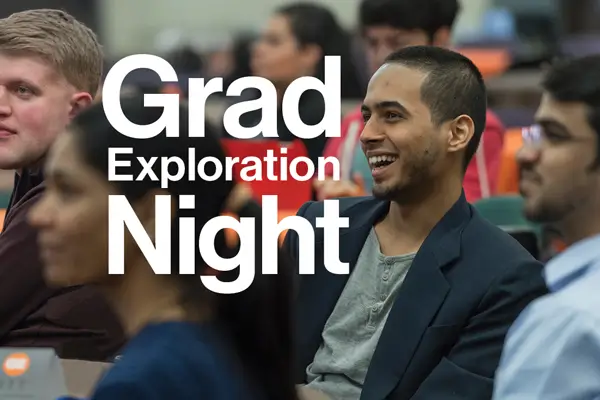Astrophysical Sciences and Technology Master of Science Degree

Astrophysical Sciences and Technology
Master of Science Degree
- RIT /
- College of Science /
- Academics /
- Astrophysical Sciences and Technology MS
Overview for Astrophysical Sciences and Technology MS
Why Study Astrophysics at RIT
STEM-OPT Visa Eligible: The STEM Optional Practical Training (OPT) program allows full-time, on-campus international students on an F-1 student visa to stay and work in the U.S. for up to three years after graduation.
Unique Interdisciplinary Approach: This is a multidisciplinary program administered by the School of Physics and Astronomy, in collaboration with the School of Mathematics and Statistics and the Chester F. Carlson Center for Imaging Science, setting it apart from conventional astrophysics graduate programs at traditional research universities.
Tailored to your Interests: The program offers tracks in astrophysics (including observational and theoretical astrophysics), computational and gravitational astrophysics (including numerical relativity and gravitational wave astronomy), and astronomical technology (including detector and instrumentation research and development).
Participate in Research: There are three research centers associated with the School of Physics and Astronomy: the Center for Computational Relativity and Gravitation, the Center for Detectors, or the Laboratory for Multi-wavelength Astrophysics.
Industry Opportunities: Graduates of the program have secured roles at the Dudley Observatory at the Museum of Innovation & Science, the National Radio Astronomy Observatory, in higher education institutions, among others.
The degree in astrophysics focuses on the underlying physics of phenomena beyond the Earth, and on the development of the technologies, instruments, data analysis, and modeling techniques that will enable the next major strides in the field.
There has never been a more exciting time to obtain an astronomy degree and study the universe beyond the confines of the Earth. A new generation of advanced ground-based and space-borne telescopes and enormous increases in computing power are enabling a golden age of astrophysics. RIT’s astronomy degree has a multidisciplinary emphasis that sets it apart from conventional astrophysics graduate programs at traditional research universities.
RIT’s Master’s in Astrophysics
RIT’s master’s in astrophysics offers students a wide range of frontier research topics in areas including multi-wavelength astrophysics, instrumentation and detector technology, computational astrophysics and gravitational wave astronomy and numerical relativity. Our guiding principle is to provide an intellectually demanding program within an informal, student-centered and supportive environment.
At RIT, you have the flexibility to tailor your plan of study to emphasize astrophysics (including observational and theoretical astrophysics), computational and gravitational astrophysics (including numerical relativity and gravitational wave astronomy), or astronomical technology (including detector and instrumentation research and development).
Pursure research interests in a wide range of topics, including design and development of novel detectors, multiwavelength studies of proto-stars, active galactic nuclei and galaxy clusters, gravitational wave data analysis, and theoretical and computational modeling of astrophysical systems including galaxies and compact objects such as binary black holes.
RIT’s astrophysics research areas include:
- Computational general relativity
- Gravitational wave astronomy
- Multi-messenger astrophysics
- Time domain astrophysics
- Experimental cosmology
- Supermassive black holes
- Active galaxie, galaxy evolution and galaxy clusters
- Proto-stars and proto-planetary disks
- Planetary nebulae
- Binary stars
- Stellar evolution
- Sub-orbital Astrophysics
- Next generation infrared detectors
- Zero read-noise detectors
Depending on research interests, you may participate in one of three research centers at RIT: the Center for Computational Relativity and Gravitation (Video), the Center for Detectors or the Laboratory for Multi-wavelength Astrophysics.
Master’s in Astrophysics Degree: What You’ll Study
A degree in astrophysics at RIT consists of four core courses, two to four elective courses, two semesters of graduate seminar, and a research project culminating in a thesis.
During the first year, you will begin a research project under the guidance of a faculty research advisor. Focus on the project becomes more significant during the second year after the core courses have been completed. A thesis committee is appointed by the program director and oversees the final defense of the thesis, which consists of a public oral presentation by the student, followed by a closed-door examination by the committee.
Careers for Master’s in Astrophysics
Alumni of our programs most often work in research positions or education programs ranging from K-12 to higher education. Alumni also are successful in computing, information technology, federal government, and imaging technology.
As a standalone research degree, the MS is a qualification for positions in data analysis or an entry into numerous other careers ranging from education to federal government. The MS also provides a stepping stone to a Ph.D.
MS to Ph.D. Transfer
For those who want to pursue a career in research, a Ph.D. provides an essential qualification. It opens the door to positions such as a university professor or staff scientist in institutions such as NASA, and to many other careers in STEM requiring analytical capabilities.
Students in the MS degree program who have excelled in their course work and research project may be permitted, by program approval, to transition into the doctoral degree in astrophysical sciences and technology, with the MS thesis defense serving as the Ph.D. qualifying examination. Such a transition from MS to Ph.D. is contingent on the availability of an advisor and research funding.
-
Affordable Now. Valuable for Life.
Earn your master’s degree without the full price tag. With Master Up you can receive a 30% tuition scholarship for an RIT master’s degree.
-
Apply early for priority consideration for admission and financial aid.
Applications are accepted after the deadline, but are only considered on a space-available basis.
-
Meet us on-campus on February 19
Learn about the programs that interest you. Hear from program faculty, speak with current graduate students, and ask the questions that will help you get one step closer to your career goals.
Careers and Cooperative Education
Typical Job Titles
| Optics Technology Supervisor | Planetarium Director | Data Analyst |
Cooperative Education
What makes an RIT science and math education exceptional? It’s the ability to complete science and math co-ops and gain real-world experience that sets you apart. Co-ops in the College of Science include cooperative education and internship experiences in industry and health care settings, as well as research in an academic, industry, or national lab. These are not only possible at RIT, but are passionately encouraged.
What makes an RIT education exceptional? It’s the ability to complete relevant, hands-on career experience. At the graduate level, and paired with an advanced degree, cooperative education and internships give you the unparalleled credentials that truly set you apart. Learn more about graduate co-op and how it provides you with the career experience employers look for in their next top hires.
Featured Work and Profiles
-
Exploring the Potential of Virtual Reality for Analyzing Astronomical Data
Ryan Butler, a Ph.D. candidate in the Astrophysical Science and Technology program at RIT, is exploring the use of virtual reality to analyze astronomical data.
Read More about Exploring the Potential of Virtual Reality for Analyzing Astronomical Data -
From RIT to Communicating with Satellites as a Spacecraft Operator
Mike Ortiz chose RIT for its research options and campus location. Today, he works as a spacecraft operator at Terran Orbital, a global leader in small satellites.
Read More about From RIT to Communicating with Satellites as a Spacecraft Operator -
AST Program Grad is now Researching Stars at the Smithsonian
RIT Astrophysical Sciences and Technology Ph.D. graduate Rodolfo (Rudy) Montez Jr. ’10 is now an Astrophysicist researching stars at the Center for Astrophysics | Harvard & Smithsonian.
Read More about AST Program Grad is now Researching Stars at the Smithsonian
Curriculum for 2025-2026 for Astrophysical Sciences and Technology MS
Current Students: See Curriculum Requirements
Admissions and Financial Aid
This program is available on-campus only.
| Offered | Admit Term(s) | Application Deadline | STEM Designated |
|---|---|---|---|
| Full‑time | Fall | February 15 priority deadline, rolling thereafter | Yes |
| Part‑time | Fall | Rolling | No |
Full-time study is 9+ semester credit hours. Part-time study is 1‑8 semester credit hours. International students requiring a visa to study at the RIT Rochester campus must study full‑time.
Application Details
To be considered for admission to the Astrophysical Sciences and Technology MS program, candidates must fulfill the following requirements:
- Complete an online graduate application.
- Submit copies of official transcript(s) (in English) of all previously completed undergraduate and graduate course work, including any transfer credit earned.
- Hold a baccalaureate degree (or US equivalent) from an accredited university or college in the physical sciences, mathematics, computer science, or engineering. A minimum cumulative GPA of 3.2 (or equivalent) with course work in mathematical, science, engineering, and computing subject areas is recommended.
- Submit a current resume or curriculum vitae.
- Submit a personal statement of educational objectives.
- Submit two letters of recommendation.
- Entrance exam requirements: None
- Submit English language test scores (TOEFL, IELTS, PTE Academic, etc.), if required. Details are below.
English Language Test Scores
International applicants whose native language is not English must submit one of the following official English language test scores. Some international applicants may be considered for an English test requirement waiver.
Duolingo (DET): 120
IELTS: 6.5
LanguageCert Academic: 70
PTE Academic: 56
TOEFL: 79
International students below the minimum requirement may be considered for conditional admission. Deaf and hard-of-hearing test takers with significant hearing loss do not need to take the listening and speaking sections for the TOEFL and IELTS. Each program requires balanced sub-scores when determining an applicant’s need for additional English language courses.
How to Apply Start or Manage Your Application
Cost and Financial Aid
An RIT graduate degree is an investment with lifelong returns. Graduate tuition varies by degree, the number of credits taken per semester, and delivery method. View the general cost of attendance or estimate the cost of your graduate degree.
A combination of sources can help fund your graduate degree. Learn how to fund your degree
Accreditation
Research
The astrophysical sciences and technology program offers students a wide range of research opportunities spanning observational and theoretical astrophysics, computational astrophysics, general relativity and gravitational wave astronomy, and the design and development of advanced detectors and instrumentation for astronomy. RIT hosts a vibrant astronomy and astrophysics research community of more than 60 faculty, post-docs, research fellows, and graduate students who participate in three designated research centers:
- The Center for Computational Relativity and Gravitation
- The Center for Detectors
- Laboratory for Multiwavelength Astrophysics
Faculty and students frequently obtain data from space observatories including the Hubble Space Telescope, the Spitzer Space Telescope, the Chandra X-ray Observatory, the Herschel Space Observatory, and various ground-based observatories such as the Gemini Observatory, twin 8.1-meter diameter optical/infrared telescopes located in Hawaii and Chile, the W. M. Keck Observatory on Hawaii, and the Very Large Array radio telescope facility in New Mexico. RIT is a member of the LIGO Scientific Collaboration, which analyzes the data taken by the Laser Interferometer Gravitational-Wave Observatory, and a member of the Legacy Survey of Space Time Corporation, which will operate an 8.4 m telescope at the Vera C. Rubin Observatory in Chile, to conduct a 10-year survey of the Southern skies.
Computing facilities include the GravitySimulator supercomputer, dedicated to N-body simulations of galactic nuclei and stellar clusters and the NewHorizons computer cluster, for numerical relativity and relativistic hydrodynamics simulations. Funding has recently been obtained to acquire an even more powerful 600-core cluster (BlueSky). Researchers at RIT's Center for Computational Relativity and Gravitation also have access to national supercomputing facilities, such as the Blue Waters supercomputer at the National Center for Supercomputing Applications at the University of Illinois at Urbana-Champaign.
RIT’s Center for Detectors operates extensive research laboratory facilities: the Rochester Imaging Detector Laboratory, Lobozzo Photonics Lab, Integrated Photonics Lab, Experimental Cosmology Lab, Suborbital Astrophysics Lab, Laboratory for Advanced Instrumentation Research, Expitaxially-Integrated Nanoscale Systems Lab, Quantum Imaging and Information Lab, and the Electrical and Optical Characterization Lab. The Center also has access to state-of-the-art simulation software, and machining and electronic assembly facilities, such as the Semiconductor & Microsystems Fabrication Lab and the Center for Electronics Manufacturing and Assembly.
Faculty involved in the astrophysical sciences and technology program regularly attract substantial external research funding from national and state agencies, including funding support from NASA, National Science Foundation, NYSTAR (Empire State Development Division of Science, Technology, and Innovation), amounting to over $12 million in the last four years.
Current research interests include:
- Strong-field gravitational dynamics of interacting compact objects such as black holes and neutron stars
- Magnetohydrodynamical simulations of the accretion disks and other astrophysical environments around supermassive black-holes
- Detection of gravitational wave signatures of binary black holes and/or neutron stars in close binary orbits
- Single Photon Counting Detectors for NASA Astronomy Missions
- New Infrared Detectors for Astrophysics
- Microgrid polarizer arrays
- Young stars and proto-planetary disks
- Chandra Planetary Nebula Survey
- Feeding and Feedback in Active Galactic Nebulae (AGN)
- AGN feedback in galaxy clusters
- Supermassive black holes in low redshift elliptical galaxies
- Reverberation mapping the circum-nuclear torus in AGN
- Stellar dynamics and supermassive black holes in galactic nuclei
- Hydrodynamical signatures of dark-matter dominated satellite galaxies
Related News
-
January 14, 2025

RIT professor leads research showing true structure of the iconic Ring Nebula
Scientists now have obtained the clearest three-dimensional view of the nebula, thanks to a research team led by Carlson Center for Imaging Science and School of Physics and Astronomy Professor Joel Kastner.
-
August 28, 2024

RIT astrophysicist named one of world's most influential female scientists
Democrat and Chronicle highlights the accomplishments of Manuela Campanelli, Distinguished Professor of Astrophysics in the School of Mathematics and Statistics. (This content will require a subscription to view.)
-
February 7, 2024

NASA, RIT Center for Detectors partner to help future spacecraft survive longer, harsher missions
RIT's Center for Detectors has been chosen by NASA for two research programs: Early Stage Innovations (ESI) and Strategic Astrophysics Technology (SAT), with the hope of helping future spacecraft find new discoveries in the vast universe.
Contact
- Lindsay Lewis
- Senior Assistant Director
- Office of Graduate Admissions
- Enrollment Management
- 585‑475‑5532
- lslges@rit.edu
- Andrew Robinson
- Director Astrophysical Sciences and Tech PhD Program
- School of Physics and Astronomy
- College of Science
- 585‑475‑2726
- axrsps@rit.edu
School of Physics and Astronomy













